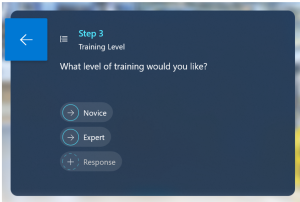Key scenarios to utilize Guides branching feature
Branching is a great Guides feature that enables users the ability to customize their workflow and take training/operations to the next level. Benefits of a custom workflow include the ability to combine multiple processes into one, reduce training time, reduce the need for custom development, and scale your business faster. First, our focus will be on scenarios for training and then on the job in a future blog. Before we dive into key scenarios to utilize branching, check out our blog post on what is branching if you are not sure about the feature or would like a review.

Expertise Levels
The first key scenario Guides branching feature should be utilized for is to create expertise levels. All employees and trainees start at different experience levels. Some may be experts while some are beginners. In traditional instructor-led training, all trainees must remain at the same pace while beginners catch up to experts. In Guides, trainees can select their expertise level thanks to branching, and they can customize their learning experience. More experienced trainees and experts can skip the beginner training instead of wasting time relearning knowledge they already know.
Exploration
Another great scenario we utilize branching for is exploration Guides. A simple use case but a great one is to allow users to choose their own learning path based on what they are curious about. If someone is interested in certain aspects of the training, they have the complete freedom to go ahead and explore on their own will. The more interested we are about a topic, the more focus and more likely we are to retain knowledge. Based on this data from Power BI Insights, companies can identify which part of the operation employees are more interested in and place them in the area they enjoy the most.
Knowledge Checks
The next scenario helps companies validate and ensure user competency when they finish a Guides training course. The last thing anyone wants is to put a new employee out on the frontline who is not competent for the task at hand. This poses many safety issues for everyone on the floor and can compromise the safety of manufactured products. To prevent this from happening, companies can implement knowledge checks during training to act as a buffer or filter to identify employees who are not ready for the front line. If a trainee cheats and skips an expertise level training scenario like mentioned above, a knowledge check prevents trainees from moving on and forces them to complete the entire training to ensure competency. Knowledge checks are also a great way to improve retention.
Diagnose/Classify
Lastly, we will cover diagnose and classify scenarios to utilize with branching. An easy way to think about the diagnose and classify branching guide is a level above the knowledge check step. Instead of quizzing trainees to evaluate their proficiency level, this scenario would validate if they correctly built a gas meter, for example. If the gas meter is built incorrectly, the guide will help walk users through what they did wrong and how to fix their mistake, so it does not happen on the frontline.


